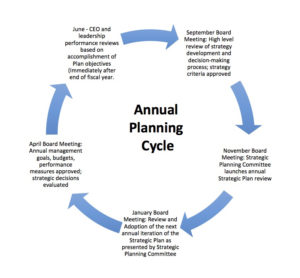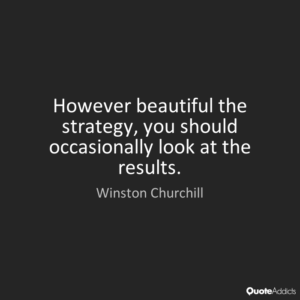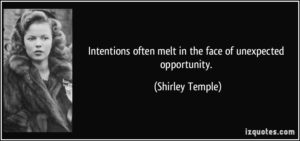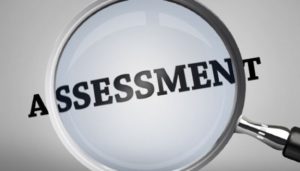
If you have followed the approach I have outlined, you have created a comprehensive, coherent strategic plan that not only describes your preferred future in high level position statements, operationalizes it through measurable goals, but also has in place a set of strategy tools to deal with unanticipated events. It all looks great on paper, but the question now is how to embed the strategic plan into the regular thinking of executive leadership and the board? Since the primary audience for these articles consists of chief executive officers, we might ask it in a little different way: “How can CEOs make sure that their organization’s strategic plan is and remains a living and dynamic document which directs the actions of the organization forward toward its preferred future?” Let me offer up a few ideas.
- First and foremost, the strategic plan has to guide the daily activities of senior leaders. In larger organizations, this might be accomplished by devoting one monthly executive staff meeting to evaluating progress toward achieving strategic goals. Such a meeting could include report-outs by those assigned to specific strategic goals or initiatives and should include metrics of progress. In smaller, less formal organizations, discussions by senior leaders should focus on the high-level priorities called out in the strategic plan, even if such discussions are around the water cooler. This focus should be modeled by the chief executive in both formal and informal conversations. There is, after all, nothing more important for executive leadership than execution of the strategic plan. So it would seem to make sense that its achievement would be the dominant topic of conversations. If it isn’t, then I would argue that the strategic plan is inadequate for its intended purpose.
- Formalizing the various levels of the process into policies and procedures ensures that certain planning and review processes occur at appointed times each year. Included in the strategic planning document should be an articulation of the organization’s planning philosophy and a broad annual schedule of planning activities. I have included a diagram which integrates the key elements that I developed for an organization that has four board meetings each year.

- Board engagement in supporting the plan can be achieved by structuring regular board meetings around the major themes of the strategic plan. Envision a board meeting in which the majority of time is spent evaluating the progress of the organization toward achieving its goals. Gone are boring operations reports. Financial reports are related to the plan, complete with scenarios and forecasts. I used this approach to good effect, not to keep the board unware of other operational matters (we published a board briefing book between board meetings which shared such information), but to help them fulfill their primary strategic, legal and fiduciary responsibilities. Boards can help their CEOs remain focused on strategy by explicitly demanding more board meeting time on strategic trends and issues. I’d even go so far as to assert that the agenda for board meetings IS the strategic plan.
- Explicit decision-making processes should be developed and utilized as an execution tool to actually drive forward the goals articulated in the strategic plan, while allowing for shifts in thinking that naturally come about in dynamic and changing environments. The CEO has to model this kind of continuous strategic decision-making and expect it of all other executives in his organization. The filters or screens for making value judgments about strategic issues that arise can flow directly from the environment scan, business model analysis, and capacity assessment that should be part of the strategic planning process.
- Let me interject a word here about consultants. It should be an expected part of every consultant contract for strategic planning facilitation to include the development and implementation of decision-making processes that support execution, implementation, learning, and adaptation. It may be necessary to utilize additional periodic consulting to advise the board and the CEO on how well its plans are being executed and to offer additional coaching and guidance. No organization should be satisfied with a “one and done” approach from a consultant. The ideal deliverable is an embedded process of strategic thinking, planning and decision-making that extends way beyond the publication of a slick planning document.
 A few articles back I wrote about the importance of data in order to measure progress toward achieving the preferred future. Whether these are called dashboard indicators, key performance indicators, operational metrics, strategic intelligence, goal statistics, or something else, they comprise what we now refer to as “business intelligence,” in other words, all the data which informs leadership about how well the organization is performing with respect to its strategic goals and objectives. For these to be of any value, however, they must be monitored regularly in order to preemptively detect any changes or developing trends. Having in place such monitoring and reporting systems ensures that leaders know if they are on track or not.
A few articles back I wrote about the importance of data in order to measure progress toward achieving the preferred future. Whether these are called dashboard indicators, key performance indicators, operational metrics, strategic intelligence, goal statistics, or something else, they comprise what we now refer to as “business intelligence,” in other words, all the data which informs leadership about how well the organization is performing with respect to its strategic goals and objectives. For these to be of any value, however, they must be monitored regularly in order to preemptively detect any changes or developing trends. Having in place such monitoring and reporting systems ensures that leaders know if they are on track or not.- Developing strategies to move toward a preferred future is not an end in itself. Implementing the strategies, monitoring their execution, learning from their impact, and being able to develop additional or alternative strategies to address conclusions from such learning – these are the critical activities needed to make the strategic plan a living and dynamic document.
- And finally, let the entire organization know where it is headed. Through newsletters, video messages to employees and stakeholders, posters and other media, the CEO is not just the visionary who sees the future, he/she must also be the story-teller-in-chief. Dreams are shared through story. The strategic plan is a dream, albeit one that may change over time, as do all dreams. But the dream will stay locked in the corner office if the story isn’t told. And, just like a television series, if you tell the story to people, they are going to want to see the next episode! If you tell the story, and it holds out an expectation, then you become accountable for making the story come true! I’ll write in more detail on this last subject in my article next week.
 Regular review of the business model, evaluating the environment to support market awareness and competitive advantage, thinking about the values and criteria that are needed to make strategic decisions as issues emerge, developing additional or alternative strategies when data suggests the need for divergence from the plan, implementation and evaluation of strategies – these are the essential ingredients of active and dynamic strategic thinking, learning and acting. And in this, as in just about every other aspect of organizational effectiveness, it comes down to leadership as to whether they are successfully utilized to move the organization toward its preferred future.
Regular review of the business model, evaluating the environment to support market awareness and competitive advantage, thinking about the values and criteria that are needed to make strategic decisions as issues emerge, developing additional or alternative strategies when data suggests the need for divergence from the plan, implementation and evaluation of strategies – these are the essential ingredients of active and dynamic strategic thinking, learning and acting. And in this, as in just about every other aspect of organizational effectiveness, it comes down to leadership as to whether they are successfully utilized to move the organization toward its preferred future.
Please contact me if you’d like to talk about this article or any other aspect of strategic planning.










